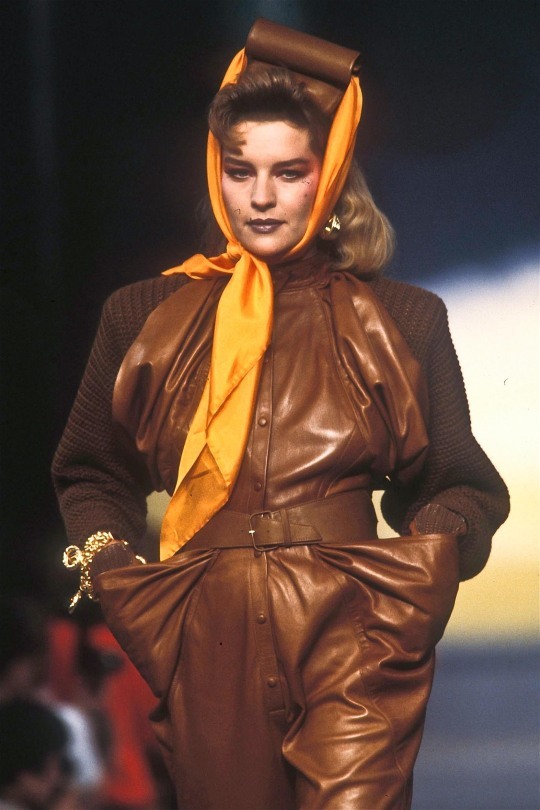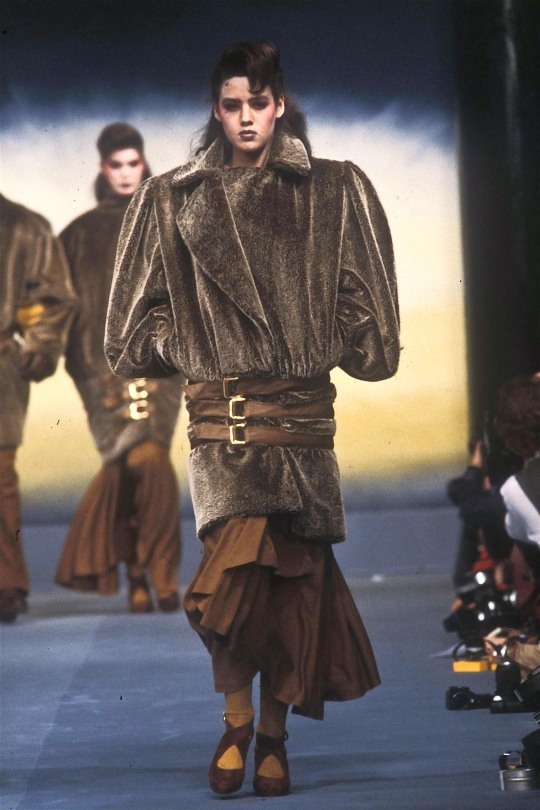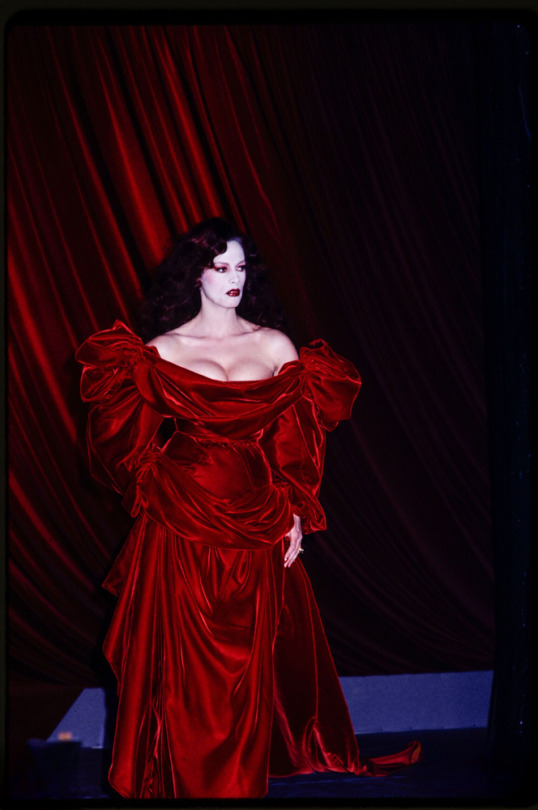#fall 1983 rtw
Text

Valentino - Fall 1983 RTW
35 notes
·
View notes
Text



Thierry Mugler - Fall 1983 RTW
@theoriginalsupermodels
10 notes
·
View notes
Text
Staying Comfortable While Staying at Home Was Years in the Making – WWD
https://ift.tt/2zfFc36
For many work-from-home-ers, an 8 a.m. Zoom meeting may only require a T-shirt and a pair of leggings. While there is nothing wrong with that combination, in this current social climate of stay-at-home, the desire to not get dressed for the day is a likely scenario. We are all victims.
Let’s consider this moment where we adopt the wear, rinse, repeat cycle with a familiar group of clothing items that need no introduction or Instagram following. The forerunners include a tank top, T-shirt, leggings, sweatpants — stop. The remainder — caftans, gowns, robes, sleep shirts and pajamas — have been around a lot longer. These minimalist shapes that have been developed in an array of natural fabrics, or chemically innovated ones, embody the definition of “comfort.”
Fashion loves history. With a timeline of discoveries surrounding clothing and human behavior, it is no surprise that the aforementioned items were discovered as early as the Bronze Age. T-shaped items, which evolved into today’s T-shirts, tanks, tunics and tank dresses. T-shaped designs were paired with string-like skirts and “chausses” leg coverings in the 15th century. It is worth noting that leggings, a staple for many staying at home, could qualify as a classic alongside the Little Black Dress and trenchcoat. For many, each of these simple silhouettes have and continue to form the basic civilian wardrobe at work, home and play.
Here is a list that considers the aesthetics of comfort via ready-to-wear collections from the 20th century forward. All prove true that’s what old is new.
• The Short Tunic was paired with short shorts from Zoran’s 1987 resort collection.
• The Night Shirt/Big Shirt was featured in Geoffrey Beene’s spring 1975 rtw collection.
• The Grecian Column was shown by Madame Gres in silk jersey during the Fifties and by Mary McFadden in the spring of 1983.
• The Robe was reimagined by Diane von Furstenberg as the wrap dress in 1972, revisited in 1998 and in many seasons since.
• The House Dress was reimagined in more relaxed versions by Halston in ultra suede for his fall 1973 collection.
• The Tank Dress made an appearance in Calvin Klein’s spring 1991 rtw collection.
• The Long Tunic was featured in Donna Karan’s 1992 Summer Essentials collection.
• The Caftan reemerged in Halston’s 1973 spring rtw collection and in Donna Karan’s 1992 Summer Essentials.
As fashion continues to cultivate ideals based on currents in our social climate, comfort is important to this continuing evolution. Although fashion is on pause, the building blocks for the stay-at-home wardrobe are endless.
It certainly hasn’t always been that way. Deirdre Clemente, who writes and teaches about the meaning of clothing at the University of Nevada, Las Vegas, noted how for centuries fashion was about being uncomfortable and about body distortion. The shift to more comfortable, less restrictive and body-baring options was partially sparked by the introduction of women’s sports in colleges, the bicycling craze of the Twenties (which allowed for shorts) and the acceptance of women wearing short skirts and no pantyhose in the Sixties, among other factors. Another major factor in the comfort-is-king trend was due to the rise of synthetic fibers, which changed how people fit in their clothes and offered them easy care options, Clemente said. “Not only do we want comfortable clothes, but we want comfortable clothes that don’t require a lot of energy.
“We’ve come to expect clothing to be comfortable in a way that other generations haven’t, because clothes are so individualized and personalized,” Clemente said. “Why should you feel uncomfortable in them as opposed to let’s say 1955, when you have to go out to pick some things up from a store, grab your kid from school and run an errand, and you have to be publicly presentable.”
The changing standard of what is appropriate to wear in public (not that that is currently a pressing concern for many stay-at-homers) is another factor. That shifted partially due to America’s car culture and people being heavier, she said. Many consider the ultra-relaxed looks that they have taken to during the COVID-19 lockdown to be more of a contemporary trend. But a further look back shows the decades long trend, Clemente said.
“I have educated fashion writers say to me, ‘Well, in the Sixties when everybody started dressing down…’I’m like, ‘Um, that’s been going on since the Twenties,’” she said. “There’s this idea that people don’t look back at things. The changing standard of what is comfortable is distracting. What will be comfortable for my kids certainly will be far from the world of what would be comfortable for my mom.”
As for how the current dressed-down trends may alter future ones, Clemente said they could “kill off the last vestiges of formality” that lawyers, hotel managers and some other professionals must adhere to. On a broader scale, she said, “I am sure 150,000 percent that this pandemic will fundamentally change the way Americans dress.”
Ruth Holliday, professor of gender and equality at the University of Leeds, offered another view of comfort in “The Comfort of Identity,” an article that centered on queer people. “What I’ve argued is that it doesn’t really matter what clothes are like if people find them comfortable and they fit their identity. It’s not the physical comfort that matters. Really anything can be thought of as comfortable as long as you feel it expresses who you are,” she said, “Wearing clothes in a particular way is telling other people, who you are. So the discomfort mainly comes from people misreading you or going against your intended expression of yourself.”
Her research has also shown that there tends to be a continuity in a person’s identity at work, as well as at rest and at play. “There was something that carried through the kind of casualwear that you have on slobbing around at home, with the kind of clothing you wear out on-the-town and the clothing that you wear at work. There is some kind of continuity in that because people still want to do something about expressing who they are,” Holliday said.
Like many, Holliday said her WFH dress codes are more comfort-driven but that will change. “I’ve completely stopped making any effort at all really in how I dress. At the moment, I’m wearing a pink fluffy fleece that belonged to my daughter, which is perfect for home working. It’s nice and warm so I don’t have to put the heating on,” Holliday said. “I’m making these very practical choices. Everything that I do is Skype or Zoom or Teams, so people only see me from the neck up anyway. Once I’m back in an office situation, I’ll probably have to go to dressing for that context.”
Post-pandemic, Holliday expects that “the fashion industry is probably going to suffer quite a lot, because obviously people will have a lot less money and [the question] is what they’re going to prioritize that on. There is a sense that fashion will become less of a priority and people might buy fewer outfits,” she said.
But given all the dress-to-impress jokes and the popularity of “Dress Up Friday,” there is a chance that people will emerge wearing their best and most impressive clothes – perhaps even wearing eveningwear to the office, according to Holliday. They may also break out their most casual clothes now that we’ve seen top celebrities, scientists and politicians in sweatshirts and other comfortable clothes. “Maybe they will be alternating between the two,” Holliday said.
Source link
قالب وردپرس
from World Wide News https://ift.tt/3gbA3JZ
0 notes
Text
People have such a fascination for top five or top ten lists. They ask questions such as Which 5 countries should I visit before I die?, If you could travel non-stop for a year, where would you go and what would you do? or Which countries do you like to suggest to tourists after they visit your countries?
After travelling three years Round The World (RTW), travelling one year in Europe, working for seven years in Europe and living/exploring in North America, that’s a hard question. We don’t think we could select just five or ten countries.
But it is not really how many countries you should or have seen. It is how you travel that is the question. Our personal philosophy is that one should experience the things that are unique to that country rather than doing the same things you would normally do. One main problem is that tourists get “museumed out” or “templed out”. The only way to get more out of your trip is to learn why the place was so significant and how each major site or work of art has influenced the next major site or work of art. The point of travelling is to learn about the culture, cuisine, people and history of your destination.
So we will give you a “short list” of our favourite places in the world — they are not being ranked and are shown in geographic order travelling westwards from North America. This post will attempt to explain at a very high level why you should visit the countries below.
Actually, I have only listed 15 countries and I’m sure I’ve left off a few special ones. We did not include places we have not yet seen like South America! Do you have any countries that you think should be added to this list? Please send us a message or fill in our Travel Destination Poll and I’ll adjust the list. This will also give us an idea of which countries you would like us to blog about.
Round The World Trip Stopovers
First of all, the countries you visit in large part will be based on the Round The World (RTW) or other ticket that you get plus any side trips you are willing to pay extra for. One rule of RTW tickets is that you cannot backtrack and must travel in a continuous westward or eastward direction. The second rule is that any ticket is only valid for one year. So we had to split our RTW trip into three tickets.
Itinerary Planning
One of the prerequisite steps for travel planning is to decide how fast you plan to travel from one site to another. You need to allow a half day or one day for travel between sites. Minor points of interest can easily be included as part of the travel day. We aim for 3 to 4 hours of driving time using Google Maps. However, it always takes longer because of meals, viewpoints, photography, et al.
Whether you are on a short trip or a RTW trip, we have a rule-of-thumb. The minimum stop for anywhere of significance is 2 full days. For a major destination allow 4 to 7 days. That does not include travel time. We like to find stopovers that we can use as a base to make day trips to nearby sights. Major destinations would be cities like Venice (Venezia), Florence (Firenze), Rome, Istanbul and Göreme. A significant destination would be a city like Ephesus.
If you have a set amount of time – like a two or three-week vacation – then work backwards to figure out how many sleep-over destinations to plan for. So, if you have two weeks you need to subtract two days for getting there and back. This means in 14 days you should only plan on five significant destinations or three major destinations.
New Zealand
New Zealand is our favourite western country with friendly people, Maori culture, dramatic volcanic and thermal areas, and great hiking. For a couple of examples of the spectacular mountain and glacial lake scenery, see the New Zealand South Island post.
Tongariro NP shown above was the first time we hiked around a volcano (actually three of them). This was a spectacular three-day “track” (Kiwi for trail). The photo shows a treacherous stretch of scoria (tiny lava balls) that provided little traction while clinging to the steep slope of the Red Crater. The trail has since been rerouted to go along the crater rim ledge above on the right. By the way, these are active volcanoes. The last eruption was in 2012.
Thailand
Morning Devata Welcome © 2014
Thailand (TH) is the place for tasty food, spectacular architecture, ancient ruins, fascinating Buddhist culture, and great national parks. For a quieter city than Bangkok, do not miss Chiang Mai, full of great food and sights. Off the tourist track is the ornate mind-blowing Wat Bupparam in the right-hand photo. It makes you think of the Baroque era in Europe but with more gold. For more suggestions see our post on our recent Thailand North trip, our third time in Thailand.
Thailand has ocean and beaches as well but that is not what is unique to Thailand. You may not realize, but what is special is that the countries of Southeast Asia are linked to India, whose traders brought them Hinduism and later Buddhism. Welcoming us to the temple above in early morning light is a devata, a Hindu celestial being. His hand gesture means namaste (Hindi) or “hello”; but it literally means “I bow to the god in you”. There are many Hindu symbols incorporated into Buddhism.
China
Great Wall © 1982
Pay homage to China (CN) for the impressive inventions that are the cornerstone of modern civilization. The Chinese loved lists even back in ancient times. One of their ancient lists is the Four Great Inventions – paper, printing, compass, and gunpowder. Western civilization is dependent on these inventions – imagine if there was no toilet paper or paper money! OK, paper money is on the way out but try to visualise before Marco Polo, everyone had to carry huge amounts of heavy metal coins to go shopping. Not fun!
Visit China for its significant contributions to art and architecture, cuisine and culture. In addition to Beijing, be sure to see the Great Wall, mandarin gardens in Suzhou, the Clay Army and Buddhist caves in Xian area, Guilin, and the Shilin, Stone Forest. Oh and you can hike the Five Great Mountains, such as Huangshan and Omeishan.
Taiwan
Sure we enjoyed the scenery in Taiwan (TW) such as Tairoko Gorge and the capital, Taipei. But don’t miss the National Palace Museum full of China’s most incredible ancient artefacts – 700,000 works of art! They were saved from the ravages of the Cultural Revolution since they were removed by the retreating Kuomintang in 1949 from the National Palace Museum in Beijing – better known as the Forbidden City. Only by seeing these artefacts will you appreciate the depth and grandeur of Imperial China.
Japan
Visit Japan (JP) for their significant contributions to art and architecture; cuisine and culture. Watch for festivals when they display their amazing silk kimonos. They have a gentle sumi-masen (so sorry) culture. Temples and palaces are based on the principle of restrained elegance – just a hint of gold against a black background – oh so effective. It is the opposite of the Baroque-like Thai decoration.
Oh did I mention the quaint gassho-zukuri (farm houses with steep thatched roofs) in Shirakawago and Gokayama?
Then there is great scenery, volcanic areas and hiking. In the fall don’t miss the maple leaves of the Japanese Alps. Then there are the groomed Medieval-like castles with ornate samurai armour. Finally, don’t miss the unique Three Great Gardens of Japan – like Kanazawa’s Kenrokuen, Saihouji (Zen Temple) & Moss Garden, Koraku-en in Okayama and Kairaku-en in Mito. OK I added one.
India
Ladahki Headress
Guman Chand Patwa was an affluent businessman who traded in zari (silver) and badla (golden) thread ornaments called patwai. But the main wealth of the family came from banking and opium trade, with some 300 offices from Jaisalmer to China! The Patwon Ki Haveli was built by the Patwa family during the 18th century and took some fifty years to build.
Visit India for the impressive inventions that are the cornerstone of modern civilization. Did you know they invented the number zero? See their significant contributions to art, and architecture, cuisine and culture. Jaisalmer (state of Rajasthan) has incredible carved buildings shown in the right-hand photo. But this is not wood –– this is embroidery in stone! Appreciate India’s cultural diversity (it has 236 languages and dialects). One Indian proudly told us that there were more differences between the states in India than between the countries in Europe.
India also has great scenery and hiking. Do not miss walking through tea plantations in Darjeeling, sipping Earl Grey tea and viewing the world’s fifth highest mountain, Kanchenjunga.
On the western side of India, you must travel to Buddhist Ladakh to see Tibet without travelling there. The Sikhs captured Ladakh from Tibet in 1834. You are in desert mountain scenery at 10,000 ft elevation (3rd image). I bet you did not think that the photo above is what the Himalayas look like. The Ladakhi woman (2nd photo) is not just wearing an elaborate headgear. That is her wealth counted in rare coral and turquoise beads.
Nepal
Annapurna Range. Pokhara © 1983
Nepal (NP) is not just about fantastic hiking and photography in the Himalayas. Kathmandu had a treasure trove of art and architecture, temples and palaces – at least until the recent earthquake. Unlike in India, the elaborate carved buildings above are carved in wood.
Turkey
View from Sunset Point © 2014
Turkey (TK) is one of our favourite countries. It is the place to see Ancient Roman ruins and architecture, amazing Islamic art and architecture, superb turquoise sea, dramatic volcano and mountain scenery, and amazing Cappadocia (above). Oh, did I mention the most friendly people?
Greece
Erechtheion © 1973-74
Ionic Column © 1973-74
Greece (GR) is a must-see for Ancient Greek art and architecture, cuisine and culture. The Greeks gave us Ionic (above) and Doric columns that decorate many classical buildings since Ancient Rome. They did not invent democracy –– the Lycians in Patara in ancient Turkey created the first parliament! But the Greeks spread it through the West and it was adopted by Ancient Rome until they reverted to military dictatorship.
Greece is also a must-go for cuisine and culture. We can still remember tasting our first lamb souvlaki in pita – it was to die for!
Italy
Pantheon © 1991
Italy (IT) is the place for friendly people who love children — our son was born in Rome. Italy has the most superb collection of art and architecture on Earth, plus a cuisine and culture that have spread around the world.
A hidden gem for non-Europeans is hiking in the dramatic Dolomites, those pointed spires of limestone. They used to below the sea! You take a funivia up to the top so that you only have to walk down! Italy is great place to see medieval and renaissance festivals with the locals dressed up in period costumes.
Switzerland
Visit Switzerland (CH) for hiking between meticulously clean, picture postcard villages nestled in scenic Alps filled with wooden chalets, glaciers and glacial lakes. Actually Alps does not mean mountains; it really means the green pastures high in the mountains. If you have a car, some of the roads between Italy and Switzerland are to die for. Unfortunately, most dramatic parts travel through covered avalanche shelters with no place to stop. Do not sightsee and drive. Instead, go hiking in Zermatt, Grindelwald, Wengen, and Lauterbrunnen. One New Jersey hiker told our Swiss friend while we were hiking that the Canadian Rockies were way better than the Swiss Alps. Needless to say, our Swiss friend was not pleased. We understand his point about true wilderness, but while they are full of civilization, the Alps are so picturesque.
Switzerland is quadralingual (German, French, Italian and Romansch) so their official name is Latin, Confœderatio Helvetica, hence why their ISO Country Code is CH. For smaller cities visit Luzurn and Bern. Don’t forget chocolate, fondu, wine and cheese tasting.
France
We have to praise France (FR) for their love of history and how well they restored their towns after World War II. When we visited a French town many years ago we were shocked to find out that it had been destroyed and was rebuilt to look exactly like the original. You would never have known. Visit France for the art and architecture, cuisine and outdoor cafes. Of course you have to visit Paris, the city that never sleeps, just for the atmosphere.
But don’t miss the chateau region, wine-tasting, off-the-beaten track Dordogne, or hiking in French Alps. Imagine taking a cable car up to a relatively flat trail (2nd photo above) at the level of the French Alps with views of Chamonix across the valley – heaven!
Great Britain
London
London Bridge
Visit Great Britain (GB) for London, Edinburgh, and Scotland in general. For something a little less touristy (only a little as UK is small, half the size of the province of Alberta or the size of Michigan) get off the city tourist track. Cornwall and Wales are renown for their coastlines. The miners from these mining regions often left for better fortunes in the new world. Now coastal tracks and hillside fishing villages like Tintagel above draw tourists.
What is unique to Great Britain, however, are the formers estates of the nobility who could no longer afford the upkeep. These estates have been acquired by the National Trust. Be sure to visit at least a couple of these heritage homes, which often come with some of the best English gardens in the country. The National Trust restores the building to its original era including finding period furniture. You come away in amazement at the wealth of the 1%.
Open-beam timber frames above can be seen in many cities in UK as well as in Germany and France. But timber-frame and thatched-roof buildings are typical of quaint villages in such areas as the Cotswolds. This is quintessential England.
United States
In the United States, visit our favourite area, the southwest with spectacular national parks and red-tinged desert canyon scenery. That is in addition to the Grand Canyon.
OK, also add Yellowstone NP further to the north. Oh and California, Oregon and Washington States. Picture Lake in the photo above, OMG! Hey we love the West even if we’re from the East. In the east it is all about cities like Washington DC and New York. But a must-do is to take the Parks Service walks of national historic monuments in Boston.
Canada
In Canada (CA) our favourite areas are the provinces of Alberta & British Columbia including the must-see Icefield Parkway of the spectacular Rockies. We are currently posting about our recent 19,000 km road trip across Canada to Yukon Territory (THE Gold Rush country as they are still mining gold there). Later we will post about the world’s most culturally diverse city (Vancouver), Vancouver Island, Canada’s Glacier NP, and the Rogers Pass area.
On the east coast, there is Nova Scotia (Cape Breton NP), New Brunswick (Fundy Bay NP) and Newfoundland (Gros Morne NP, icebergs), all come with superb seafood, fish and chips. Newfoundland, which has the friendliest people, was the island that led to the discovery of North America in 1500 by Europe. Move over Cristoforo Colombo! It’s about time we use his real name, Anglophones. He was a vero Italiano. America (i.e. Newfoundland) was actually first discovered in 1000 CE by the Vikings, but they kept that secret to themselves. You can visit the proof of their existence.
Now it’s your turn. Which countries do you think should be added to this list? Please send us a message or fill in our Travel Destination Poll and I’ll adjust the list.
The point of travelling is to learn about the culture, cuisine, people and history of your destination #travel #amazing #hiking #nature #photography #RTW People have such a fascination for top five or top ten lists. They ask questions such as…
0 notes
Text

Valentino - Fall 1983 RTW
26 notes
·
View notes
Text

Valentino - Fall 1983 RTW
22 notes
·
View notes
Text

Valentino - Fall 1983 RTW
31 notes
·
View notes
Photo

Thierry Mugler - Fall 1983 RTW
297 notes
·
View notes
Photo

Thierry Mugler - Fall 1983 RTW
174 notes
·
View notes
Photo

Thierry Mugler - Fall 1983 RTW
220 notes
·
View notes
Text

Valentino - Fall 1983 RTW
45 notes
·
View notes
Photo

Thierry Mugler - Fall 1983 RTW
109 notes
·
View notes
Photo

Thierry Mugler - Fall 1983 RTW
60 notes
·
View notes
Photo

Thierry Mugler - Fall 1983 RTW
55 notes
·
View notes
Photo

Thierry Mugler - Fall 1983 RTW
55 notes
·
View notes